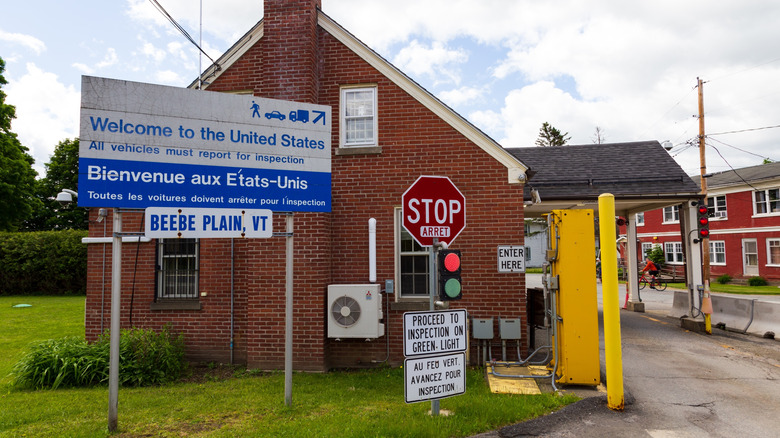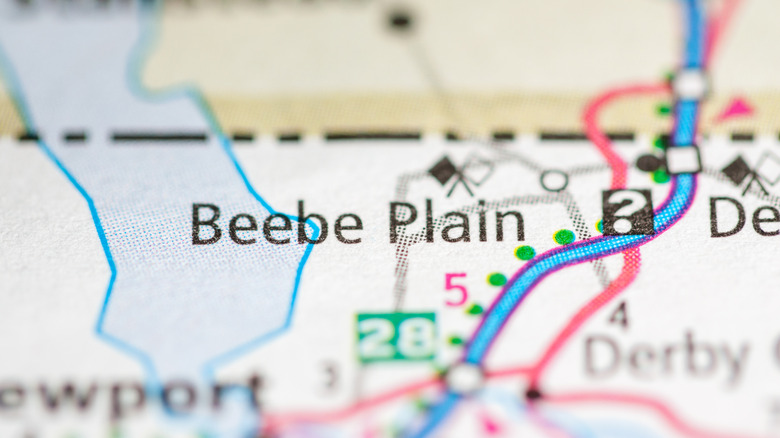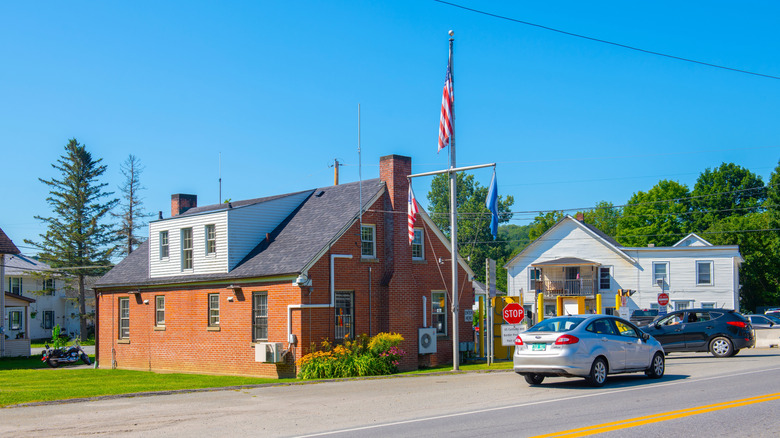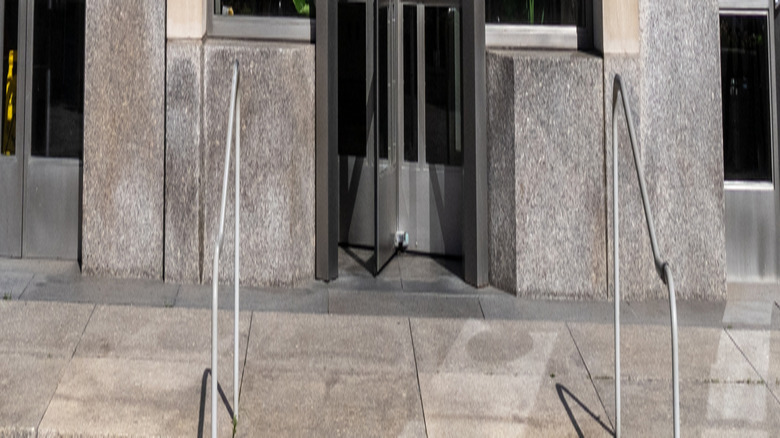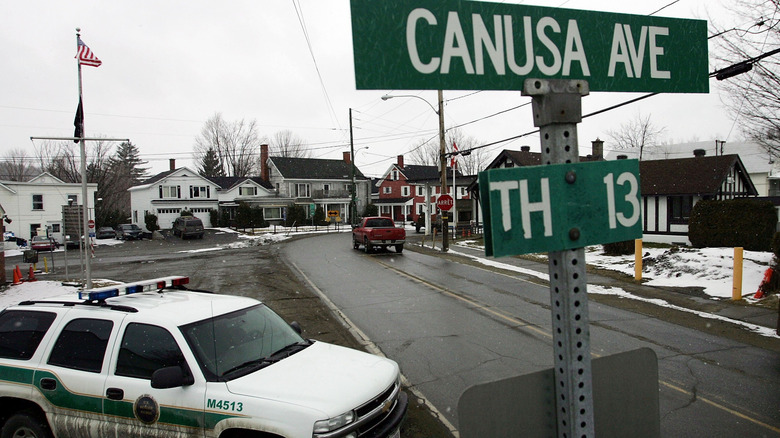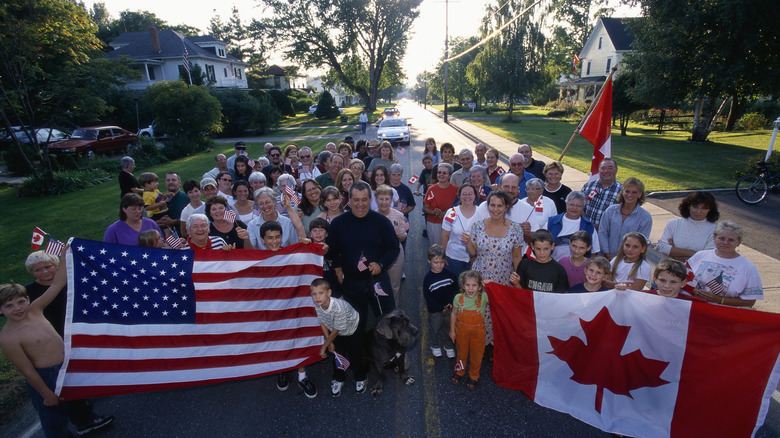The Town That's Literally Cut In Half Along The United States And Canadian Borders
Picture this: You wake up on a typical Tuesday morning, yawn, groan a bit, curse your alarm and perhaps your boss, and eventually roll out of bed and plod around the house getting ready for work. There's teeth brushing involved, some clothing selecting, a bit of grumblingly swigged coffee, and it's out to the car to hit the road. You pull out of your driveway, hook a left, and immediately join the half-mile-long queue to leave your country through a drive-through port of entry. Otherwise, you can't even leave your residential road.
If this sounds absurd to you, then congratulations: You're not one of the handful of residents on Canusa Avenue in Beebe Plain, Vermont. Or one of the 850 or so residents of Beebe Plain, Quebec. You don't find it nearly impossible to reach your home after work, which is in another country on the opposite of the street. You aren't so harassed by continually tightening regulations — especially since 9/11 — that you want to leave but can't sell your house because no one wants to deal with such ridiculousness. And you aren't sad Brian DeMoulin, whose house is cut diagonally by the U.S.-Canadian border and whose ideal tenet has dual citizenship so they can cross the living room or something.
All of the above is true. Welcome to Beebe Plain, a town with one foot in Canada and the other in the United States. No one knows how it got this way, except that maybe alcohol was involved. And, it's not even the only town of its type.
The annoyances and complexities of living in Beebe Plain
All it takes is a little look at Google Maps to spot the predicament for folks living on Canusa Avenue in Beebe Plain. We call out this road, in particular, because Beebe Plain's cross-border problem is limited to this one road. The southern side of the road is a string of 14 houses in Vermont, while the rest of the town is on the northern, Quebecois side. Granted, it doesn't look like there's much on that side except a bakery from which to stand and laugh at the line of frustrated drivers going through border control — laughing in French, no less. So if you live on the Canadian side, you might be alright. If you live on the U.S. side, you're screwed.
A 2018 article on VT Digger revealed the daily aggravations facing locals. Resident Janice Beadle described having to plan her entire day, every day, around multiple passes through border control. Louise Boisvert described feeling "shame" every time she gets scrutinized passing through the port of entry. Other residents described the chokehold of every-tightening security measures, like hydraulic barriers, security cameras, narrow lanes, etc. Yet others describe how none of this existed when they were kids.
Then there's the traffic that always backs up down Beebe Road and its connecting road, Darling Hill Road. These roads ingeniously funnel traffic directly onto the contested street, Canusa Avenue. But at least if you stand on either side of Canusa Avenue, you can hold out your arm over the double yellow line and stick it in another country. Suck it, border control.
Beebe Plain isn't the only town of its type in its area
In case you thought that the cross-country troubles of Beebe Plain are limited only to Beebe Plain, we turn your attention to the neighboring Derby Line. Why Derby Line and not just Derby? Maybe because of the big, ole' line cutting through the town that separates Canada from the United States. And how close is this similarly hobbled town to Beebe Plain? Four minutes by car.
Unlike Beebe Plain, Derby Line is more of a town rather than a collection of houses. The northern, Canadian side has some schools, restaurants, churches, a hockey rink, and a Tim Hortons. The southern, American side has some churches, an RV park, a gun shop, and presumably smells like freedom. Both sides have loads of trees. And like Beebe Plain, Derby Line has a drive-through port of entry on either side of the border along a single street. But in this case, the street changes names at the border because the border cuts the street short-wise, not along the double yellow line. On the U.S. side, the street is called Main Street. On the Canadian side, it's called Rue Dufferin presumably to remind people to buy Bufferin to deal with stupid border crossings.
Besides all of the troubles we described besetting Beebe Plain, Derby Line also has the Haskell Free Library and Opera House cut into international halves. There's even a black line running across the floor of the building's rooms. No word if there are separate entrances for Americans and Canadians.
Vermont has no say in Beebe Plains' border security
To anyone with a smidgen of common sense, it likely seems ludicrous that the residents of Beebe Plain or Derby Line to have to flash their passports every day to employees who clearly know them, or queue under the low-ceiling canopy of a port building. But to the powers that be, this is a normal, natural measure to take.
Or at least, it became normal after new security measures were put in place in 2018. As U.S. Customs and Border Protection Assistant Area Port Director Kevin Coy told VT Digger, there were some drivers who passed by the port of entry without stopping. Hence the new hydraulic barriers we mentioned. Coy said, "We're always looking for ways to enhance our ability to complete the mission, and this is something relatively new and efficient that we've discovered that we thought would improve our capabilities, without hindering back-and-forth traffic." Someone should tell him that this last part didn't quite work out.
Coy represents the federal government, which has "broad powers at international borders," per Jacqui DeMent of the Vermont Department of Transportation on VT Digger. "Under Vermont law, the subject roads in Vermont are town highways, under the jurisdiction of municipal authorities," DeMent said. In other words: The state of Vermont has no say in matters related to port of entries in Beebe Plain or Derby Line. This is true even though locals bear the brunt of the aggravation incurred by ever-tightening security measures.
The unknown origins of Beebe Plains' dual-country status
So why, oh why, would anyone build a town across the border between two countries? Maybe there was a log cabin there before the border was drawn. Maybe the town boundaries and the country border were there, but the zoning or property purchasing/construction was imprecise. Or as locals say on VT Digger, we can blame it on alcohol. In this version of the tale, a "group of surveyors" was boozing in the area and drew the U.S.-Canada border right through Canusa Avenue. Locals also say that there was once a bright, shining time of human brotherhood when the border straight-up didn't exist.
Not to spoil the fun or anything, but this origin story is probably bogus. Vermont became a state way back in 1791, eight years after the Treaty of Paris designated the latitude of 45 degrees north as Vermont's northernmost boundary. David and Calvin Beebe settled Beebe Plain in 1798, per "Forests and Clearings: the History of Stanstead County, Province of Quebec, with Sketches of More Than Five Hundred Families." That happened nearly 70 years before Quebec joined Canada as a province in 1867. Still, by 1820, there were already brick buildings, general stores, and houses right at the Vermont border with Canada. And, it took until 1937 for Beebe Plain's U.S. Border Station to go under construction — the same drive-through port of entry that exists in Beebe Plain today.
So what's the real story behind Beebe Plain's and Derby Line's dual-country status? Human error makes sense. Measurement tools have gotten way more precise than before.
From joined community to separated by invisible lines
Now we get to the final, human cost of the invisible but very legal border line cutting straight down Canusa Avenue in Beebe Plain. The port may be open 24/7, and transnational neighbors can still wave at each other across the street and maybe hand each other an illegal, non-customs-authorized egg for baking a cake. But the weight of increasing regulations and the incessant scrutiny of Big Brother's all-seeing eye are crushing the local spirit bit by bit.
Per VT Digger, Patrick Boisvert says that when he was a kid, Beebe Plain really was a bright, shining model of human brotherhood. "My best friend when I was growing up lived in that house across the street, so we were back and forth across that street a hundred times a day," he said. He was "free range" and rode his bike everywhere, including all around the Canadian side of the border. Folks in the area also had dual citizenship and shared culture, language, families, churches, doctors, etc. Even now, 18.3% of the people on the American side of the border are of French-Canadian descent, and 6.4% speak French.
Realistically, cops aren't going to instantly tackle a person who breathes near the double yellow line. And yet, all of the security cameras (sometimes placed in trees) and surveillance discourage people from interacting with those across the border, even if that border is just the middle of the street.
